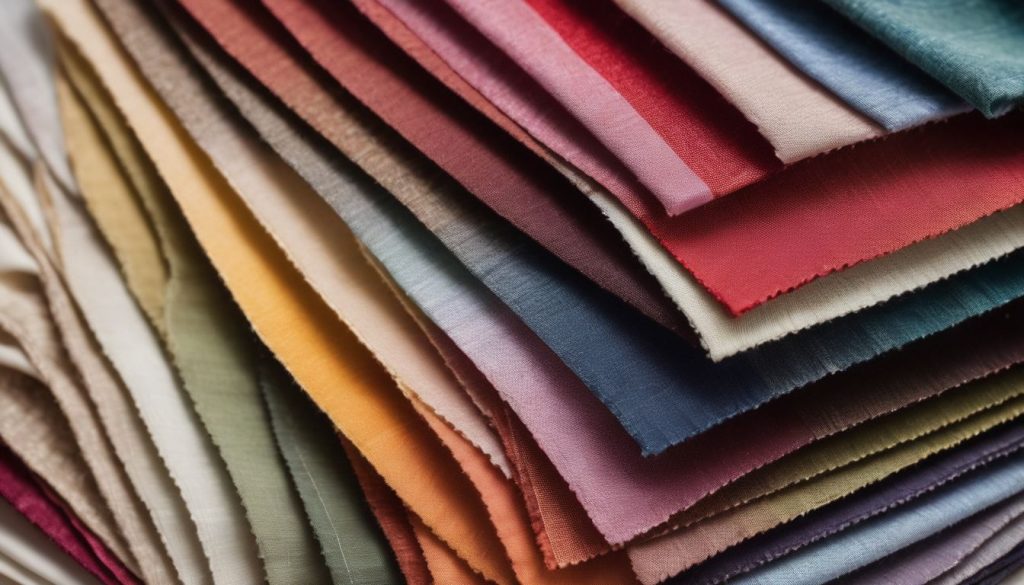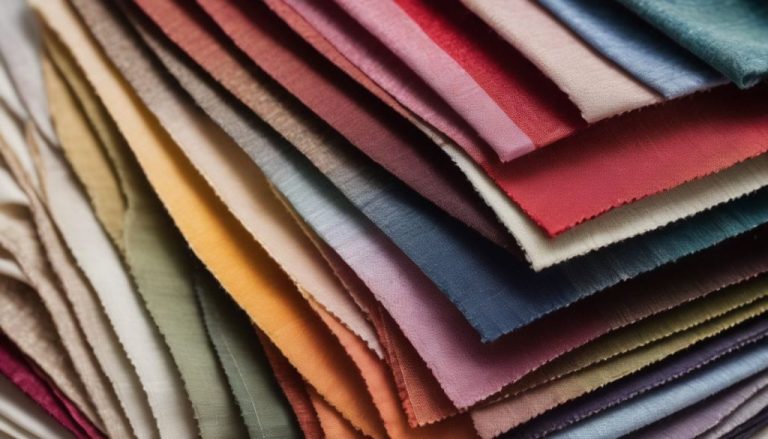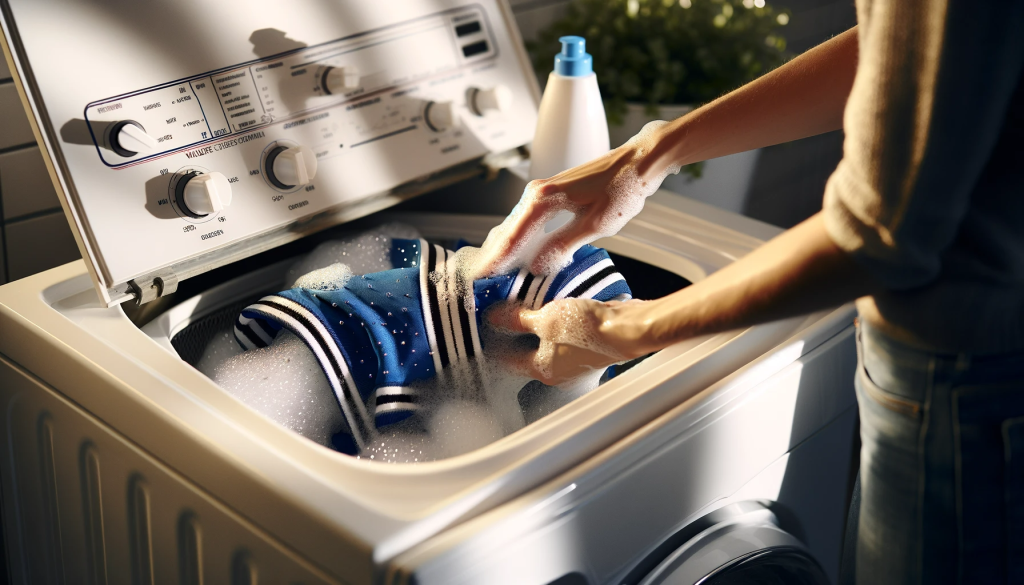From silk to suede, navigating the world of fabric care can be challenging, but knowing which items need professional attention can save you from costly mistakes. Dive into our comprehensive guide and explore expert tips to keep your cherished garments in pristine condition—your next journey into fashion begins at inktasticmerch.com.
Has your favorite sweater ever been accidentally shrunk? While wool is a hardy fabric, it demands particular attention to stay in prime condition. Our guide will demystify which fabrics require professional dry cleaning and which can be safely washed at home.
Continue reading for some expert advice!
Key Takeaways
- Fabrics such as silk, velvet, wool, leather, linen, and suede must be dry cleaned professionally to preserve their appearance and quality.
- Materials like cotton, knits, polyester, and denim are fit for home washing, provided you adhere to specific instructions to avoid any mishaps.
- Special fabrics such as cashmere and fur need careful handling—opt for expert services or follow precise hand-washing guidelines.
- Items with embellishments should be cleaned professionally to protect delicate beading or sequins from the rigors of a regular wash.
- Always examine clothing care labels thoroughly before cleaning; they offer crucial details on how to maintain fabric integrity.
Fabrics That Need Professional Cleaning

Silk, velvet, wool, leather, linen, and suede necessitate professional dry cleaning to retain their elegance and quality. Read on to discover how to care for these exquisite textiles.
Silk
Caring for silk involves handling it with care, as this exquisite material is renowned for its fragility. It’s wise to place your silk garments in the hands of professional dry cleaners who are skilled in treating such delicate fabrics using environmental-friendly solvents.
This specialized attention aids in preserving silk’s sleekness and vibrant hues without exposure to harsh chemicals.
When dealing with raw silk or luxurious pieces like Douppioni and Crepe, expert garment care becomes crucial. These silk types are vulnerable to machine washing due to the aggressive agitation and heat involved.
Handwashing is an alternative but demands utmost precision to avoid shrinking or damaging the fragile fibers. Trust a reputable cleaner with your sensitive fabrics. Proper upkeep can significantly prolong the lifespan of your beloved silk garments.
Velvet
To sustain their opulent feel and deep colors, pure velvet garments should undergo dry cleaning. Different types of velvet require distinct care approaches; knowing their specific needs is essential for adequate preservation.
If you possess polyester or crushed velvet items, safely nestle them in a mesh laundry bag and machine wash with cold water on a gentle cycle. This measure prevents snagging and tearing.
For velvet upholstery spills, quickly use a damp cloth to clean messes owing to its robust and stain-resistant nature. Utilize cool water when hand washing fragile pieces and choose detergents tailored for delicate fabrics.
These measures keep your velvet possessions pristine while safeguarding the material’s distinctive attributes.
Wool
Wool necessitates meticulous care during washing. This naturally thick fabric is prone to warping or shrinking if mishandled. For fragile items like vintage coats or handcrafted blankets, handwashing in cold or tepid water with a gentle detergent is advisable.
Let these items soak appropriately to avoid overhandling.
To prevent damage, pay close attention to fabric care instructions and check labels carefully before washing your woolens. These labels often contain essential care guidelines. If the wool item is machine washable, use a gentle cycle, opt for a wool-specific detergent, and select a low spin speed.
Exercise caution with drying methods—some wool garments can be tumble dried, whereas others should be laid flat to dry to maintain their shape and texture. Shifting focus to another fabric needing thoughtful care, leather demands expert attention.
Leather
Transitioning from the delicate care of wool to another material requiring professional intervention, leather requires specialized treatment. Cleaning leather professionally involves using specific equipment and chemicals to effectively remove dirt and stains.
After cleaning, allow leather items to air dry naturally, keeping them away from direct sunlight or heat sources to prevent fading or damage. Regular maintenance includes wiping a leather jacket with a soft, dry cloth to maintain its cleanliness and appearance.
A periodic deep clean ensures that apparel remains hygienic and safe to use, which can also be cost-effective in the long term.
Linen
Linen can be safely dry cleaned or machine washed, except when the label indicates “hand wash only.” Taking linen garments to a professional dry cleaner is advisable, as they are equipped with suitable methods and chemicals for cleaning.
Dry cleaning avoids water, which might compromise the fabric’s texture.
Properly manufactured and treated linen can endure machine or hand washing and even tumble drying on low heat if necessary. Linen can be cared for via machine washing, hand washing, or dry cleaning, depending on the instructions provided.
Suede
Suede, known for its velvety texture, necessitates professional dry cleaning due to its porous nature. Annually, it’s advisable to have suede professionally cleaned to preserve its look and lifespan.
Washing suede in a machine can harm the fabric, so dry cleaning services that specialize in this delicate material are essential. Surface stains on suede shoes can be gently removed using a suede shampoo and a nylon brush.
Also, routinely brushing suede every one or two weeks can effectively eliminate surface dirt and debris, maintaining its appearance.
Fabrics That Can Be Washed at Home

Cotton, knits, polyester, and denim are fabrics that are generally safe to wash at home. However, it’s crucial to consult the care labels on your clothing for correct cleaning instructions.
Cotton
Cotton can be effortlessly cleaned at home using cold or lukewarm water in a washing machine. To preserve its longevity, avoid over-drying and exposure to hot water, which may cause shrinking.
Adhering to these simple fabric care guidelines ensures your cotton garments remain fresh and vibrant longer.
Maintaining cotton involves selecting suitable washing settings and cooler water temperatures to avoid shrinkage. Practice caution during drying to avoid over-drying and extend the life of your beloved cotton pieces.
Knits
Knits, including wool and cotton, require thoughtful care and can be effectively maintained using these methods.
Blended fabrics can be conveniently washed at home using the gentle cycle of your washing machine or by hand. To care for knitwear, opt for a mild detergent and cold water to prevent any shrinkage or damage to the material.
Even garments that state “dry clean only” can be safely cleaned at home by following the correct care instructions. For special materials like wool, it’s advisable to hand wash or seek professional dry cleaning to ensure they retain their quality.
Knits need gentle handling during cleaning because of their stretchy and sensitive nature, so always consult the care label for specific maintenance guidelines.
Polyester and Other Synthetics
Fabrics like polyester, nylon, and acrylic are usually machine washable. Always read the care label for any specific recommendations about water temperature and other washing directions.
While most polyester blends tolerate warm or cold water, avoid using hot water as it may cause shrinking or distortion. For drying, air drying or using a low-heat tumble dryer is best to avoid damage.
If polyester garments are soiled but don’t need a full wash, spot cleaning with a mild detergent and water is a practical method to keep them fresh. Avoid bleach or harsh chemicals to prevent discoloration or fabric damage.
Denim
True denim should be washed sparingly to preserve its color. If marked “dry clean only,” it’s best to avoid putting it in a washing machine.
Professional dry cleaners know how to expertly handle and clean delicate fabrics like denim. If your denim needs a wash, use the delicate cycle with cold water.
Denim clothing doesn’t require washing after every wear and should only be cleaned when it becomes dirty from stains, soil, or odors.
Caring for Special Items
Proper care is essential for your cashmere sweaters and furs, as well as understanding how to manage embellished items and other delicate or synthetic materials.
Cashmere
Cashmere, with its luxurious yet delicate nature and inherently antibacterial properties, doesn’t need to be washed as frequently as synthetic fabrics. Most cashmere garments can be dry cleaned in accordance with their care labels to keep the fibers in excellent condition.
It’s best not to clean wool and cashmere sweaters after each wear, as this can damage the yarns. Store cashmere by folding, rather than hanging, to maintain quality.
Hand washing or professional dry cleaning is advisable for maintaining cashmere items, as these methods can preserve their delicate structure. Instead of wringing or twisting, lay the sweater flat on a clean surface to dry to prevent stretching or damage.
Furs
Transitioning from delicate cashmere care to furs, it’s important to acknowledge the unique maintenance fur garments require. Professional care is key when cleaning and storing furs.
Furs should be kept away from heat and stored in cool, spacious environments to maintain their excellent condition. It’s also crucial to avoid friction and chemical exposure to keep fur pieces in prime shape over time.
Fur care experts are well-equipped to carefully inspect each garment before cleaning. They thoroughly examine for any stains, rips, or tears, devising a customized cleaning strategy as needed.
Embellished Items
Embellished
items like beaded or sequined garments and hand-stitched accessories often demand special attention due to their delicate construction. These intricately adorned pieces should be entrusted to professional dry cleaners to keep their embellishments intact and unharmed.
Hand-stitched elements can unravel when exposed to the rigors of a typical washing machine, and the fine beadwork or sequins might not survive the agitation. Trusting these items to experts ensures their elegance is preserved, without the risk of damage.
When it comes to handling bedazzled outfits or jeweled accents, recognizing the delicate nature of these decorations is crucial. Professional dry cleaning offers a gentle yet thorough approach, safeguarding the decorative features of your ornate clothing and accessorized apparel.
Fragile or Synthetic Materials
Materials such as chiffon, tulle, and rayon require gentle handling to maintain their integrity. Dry cleaning is advisable to sustain the quality of these delicate fabrics. Conversely, some synthetic materials like PVC and polyurethane are unsuitable for dry cleaning and might suffer damage during the process.
It’s essential to review the fabric labels or seek professional advice for optimal care instructions for fragile or synthetic materials.
For natural fibers, including linen, wool, rayon, silk, viscose, lyocell, modal, and cupro, dry cleaning is beneficial in retaining their form and texture, especially as these fabrics often react adversely to water. Employing meticulous cleaning methods ensures these fibers preserve their quality over time.
Caring for Special Items
Handle furs, suits, pleated garments, and similar items with diligence, adhering to specific guidelines and always inspecting the labels before cleaning. For more valuable fabric and garment care insights, continue reading!
Tips for Handling Furs, Suits, Pleated Items, and More
When dealing with furs, suits, or pleated apparel, consult the care label for dry cleaning specifics. Use a soft-bristled brush to carefully eliminate surface debris from fur and store it in a cool, dark environment.
Suits benefit from brushing after each wear and occasionally visiting a professional cleaner to keep their appearance sharp. Avoid hanging pleated attire for extended periods to prevent lasting creases.
For fragile or synthetic items, such as those with sequins or other embellishments, address stains with a mild detergent before reaching out to a professional. For exquisite fabrics like silk or velvet, shield them from direct heat and sunlight during storage to maintain their texture and color.
The Importance of Reading Labels and Following Care Instructions
Understanding and adhering to garment care symbols and instructions is vital for preserving the integrity of special fabrics and items. Labels provide crucial advice on how to care for various materials properly, contributing to their durability.
By adhering to recommended fabric care practices and washing instructions, individuals can avoid potential damage to delicate fabrics and extend the lifespan of their clothing. Hence, it’s essential to meticulously follow laundry care labels and textile care guidelines to ensure appropriate fabric maintenance.
Proper fabric care involves scrutinizing clothing care symbols and directions thoroughly before washing or cleaning any item. This diligence not only maintains the fabric’s quality but also prevents unnecessary abrasion or harm resulting from improper treatment.
Conclusion
In summation, attentive care of different fabrics is crucial for preserving their quality and longevity. Understanding which fabrics require dry cleaning and which can be safely washed at home aids in maintaining the condition of your apparel.
ByBy adhering to label care instructions and recognizing the unique needs of each fabric, you can keep your clothes looking their best for an extended period. Properly tending to delicate textiles is essential to maintaining a pristine wardrobe.
Ensuring each fabric is handled according to its specific care requirements is crucial to preserving its quality.
FAQs
1. How can I tell if a fabric needs dry cleaning?
Look for “dry clean only” or “dry clean recommended” on the garment’s care label.
2. Is hand washing possible for items marked as dry clean only?
For items labeled “dry clean only,” it’s advisable to follow the label’s guidance and use professional cleaning services to prevent fabric damage.
3. What fabrics always require dry cleaning?
Fabrics such as silk, wool, velvet, and garments with structural linings usually need dry cleaning to preserve their quality.
4. Which items commonly need dry cleaning?
Frequently dry-cleaned items include suits, formal attire, coats, delicate curtains, and garments made from silk or wool.
5. How should clothes be stored after dry cleaning?
After picking them up from the cleaners, remove any plastic wrapping to allow garments to breathe, and store them in a cool, well-ventilated area away from direct sunlight.
To deepen your understanding of fabric care and other intriguing topics, venture into our Blog for more insightful articles.




